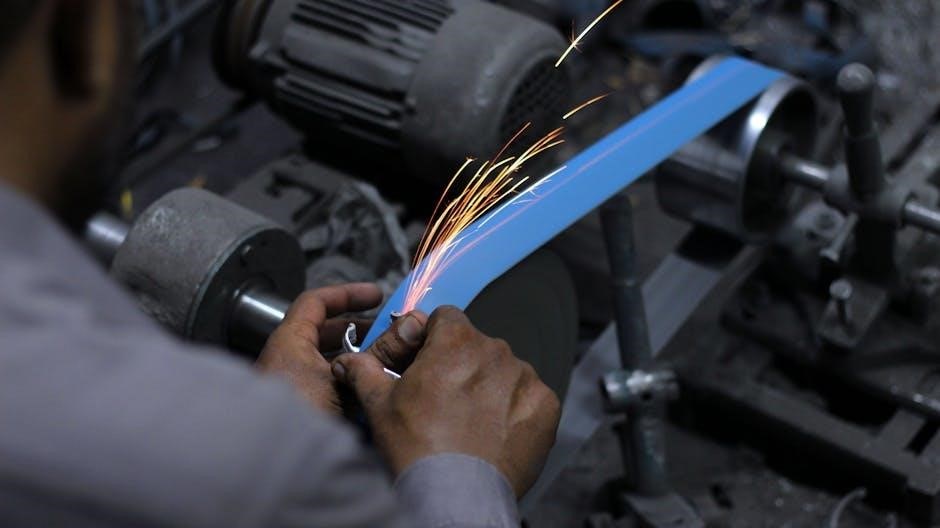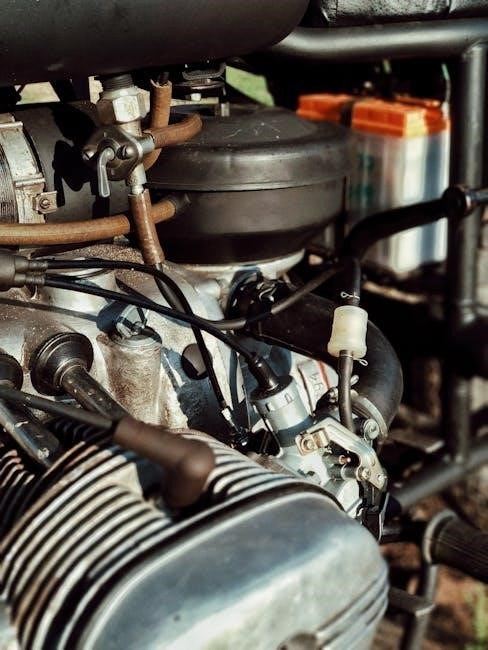Tecumseh motor manuals provide essential guidance for operating, maintaining, and repairing Tecumseh engines, covering models like ECV100-120 and H22-80. They ensure safe and efficient engine performance.
1.1 Overview of Tecumseh Engines
Tecumseh engines are renowned for their reliability and performance in various applications, including lawn mowers, generators, and small equipment. These engines are designed to deliver consistent power and durability, with models ranging from 3 HP to 11 HP. They feature four-cycle, air-cooled designs, ensuring efficient operation in diverse conditions. Tecumseh engines are widely used due to their compact size, fuel efficiency, and ease of maintenance. Proper operation and care, as outlined in official manuals, are crucial for maximizing their lifespan and performance.
1.2 Importance of Using Official Manuals
Using official Tecumseh motor manuals is crucial for ensuring safe and proper engine operation, maintenance, and repair. These manuals provide accurate, model-specific instructions tailored to your engine, reducing the risk of errors or damage. They include essential safety precautions, troubleshooting guides, and compliance information. Official manuals are designed to help users maximize engine performance, extend lifespan, and avoid costly repairs. Always refer to the manual for your specific engine model to ensure adherence to manufacturer recommendations and regulatory standards.
1.3 Safety Precautions When Handling Engines
Always follow safety guidelines when handling Tecumseh engines to prevent accidents. Avoid fuel siphoning by mouth and ensure proper ventilation to prevent carbon monoxide poisoning. Never smoke near engines or fuel tanks. Keep loose clothing and long hair tied back to avoid entanglement. Use protective gear like gloves and eyewear. Ensure the engine is cool before servicing and follow correct shutdown procedures. Adhere to these precautions to ensure personal safety and comply with manufacturer recommendations for safe engine operation and maintenance.

Tecumseh Engine Models Covered in Manuals
Tecumseh manuals cover various engine models, including ECV100-120, H22-80, HH40-70, HM70-100, and HMSK70-110, providing detailed specifications and repair guidance for each model.
2.1 ECV100 ⏤ 120 Engine Models
The ECV100-120 engine models are widely used in outdoor power equipment, offering reliable performance for applications like lawn mowers and generators. These engines feature horsepower ratings ranging from 10 to 12 HP, with a focus on durability and efficiency. Designed for horizontal shaft applications, they include features like overhead valve technology and cast-iron cylinders for longevity. The manuals provide detailed specifications, maintenance schedules, and repair instructions tailored to these models. They also emphasize safety precautions and proper fuel usage to ensure optimal engine performance and extend service life.
2.2 H22 ⸺ 80 Engine Models
The H22-80 engine models are compact and versatile, designed for small to medium-sized outdoor power equipment. With horsepower ratings between 7 and 11 HP, these engines are ideal for applications like lawn mowers, trimmers, and generators. Known for their reliability and fuel efficiency, they feature overhead valve technology and cast-iron cylinders for added durability. The manual provides detailed specifications, maintenance tips, and repair instructions specific to these models, ensuring optimal performance and longevity. Safety guidelines and troubleshooting tips are also included to address common issues effectively.
2.3 HH40 ⏤ 70 Engine Models
The HH40-70 engine models are high-performance engines designed for demanding applications, offering horsepower ratings from 14 to 23 HP. These engines feature advanced ignition systems and efficient cooling mechanisms, making them suitable for heavy-duty equipment like tractors, pumps, and industrial machinery. The manual includes detailed service instructions, parts diagrams, and troubleshooting guides tailored to these models. Emphasis is placed on routine maintenance, proper fuel usage, and safety precautions to ensure reliable operation and extend engine lifespan.
2.4 HM70 ⏤ 100 Engine Models
The HM70-100 engine models are high-output engines with horsepower ranging from 23 to 30 HP, designed for heavy-duty applications. These models feature robust construction, advanced cooling systems, and enhanced ignition technology for consistent performance. The manual provides comprehensive service and repair guidelines, including detailed parts diagrams and troubleshooting tips. Emphasis is placed on proper maintenance, fuel recommendations, and safety protocols to ensure optimal engine functionality and longevity, making them ideal for industrial and agricultural use.
2.5 HMSK70 ⸺ 110 Engine Models
The HMSK70-110 engines are high-performance models with horsepower ranging from 23 to 35 HP, engineered for demanding applications. These engines feature advanced cooling systems, improved ignition technology, and robust build quality. The manual offers detailed service instructions, parts diagrams, and troubleshooting guides. Emphasis is placed on routine maintenance, proper fuel usage, and safety measures to ensure reliable operation and extended lifespan, making these engines suitable for industrial and heavy-duty agricultural equipment.

Engine Parts and Identification
This section covers essential engine components, such as cylinders, spark plugs, and pistons. The manual provides detailed charts and decoding of model numbers for accurate identification.
3.1 Understanding Engine Serial Numbers
Engine serial numbers are crucial for identifying Tecumseh engines, providing details like model specifications, horsepower, and production dates. These numbers are typically stamped on the blower housing or a decal. By decoding the serial number, users can determine the exact engine model, ensuring accurate repairs and part ordering. This information is vital for maintaining compliance with emission standards and troubleshooting specific engine issues effectively.
3.2 Decoding Model Specifications
Decoding Tecumseh engine model specifications is essential for understanding performance capabilities and maintenance needs. Models like ECV100-120 and H22-80 are detailed in manuals, outlining horsepower, torque, and cylinder configurations. Specifications also cover emission compliance, ensuring engines meet environmental standards. By referencing the serial number, users can accurately identify their engine’s unique features and requirements, enabling proper servicing and repairs. This information is critical for selecting the right parts and ensuring optimal engine operation.
3.3 Locating Parts Identification Charts
Parts identification charts are crucial for accurately identifying and ordering components for Tecumseh engines. These charts are typically found in the manual’s catalog section, detailing each part’s number, description, and quantity. For models like ECV100-120 and H22-80, the charts provide exploded views, making it easier to locate specific components. Users can cross-reference these charts with the engine’s serial number to ensure accuracy. This section helps technicians and DIYers efficiently identify and procure the correct parts for maintenance or repairs, ensuring optimal engine performance and longevity.

Service and Repair Instructions
Tecumseh motor manuals offer comprehensive service and repair instructions, including routine maintenance, oil changes, and troubleshooting guides for models like ECV100-120 and H22-80 to ensure proper procedures and extended engine life.
4.1 Routine Maintenance Schedule
A routine maintenance schedule is crucial for optimal engine performance. Regular tasks include oil changes every 50 hours, air filter cleaning, and spark plug inspections. Ensure proper lubrication and check for worn parts. Refer to the manual for specific intervals tailored to your engine model, such as ECV100-120 or H22-80. Adhering to this schedule prevents premature wear, reduces repair costs, and extends engine lifespan. Always follow the recommended guidelines for your Tecumseh engine to maintain reliability and efficiency.
4.2 Oil Change and Lubrication Guidelines
Regular oil changes are vital for maintaining Tecumseh engine performance. Use clean, unleaded gasoline and high-quality motor oil suitable for your engine type. Drain the oil when the engine is warm for efficient removal. Always refer to the manual for specific oil viscosity recommendations. Ensure the oil filler cap is securely replaced after servicing. Proper lubrication prevents engine wear and ensures longevity. Follow the manual’s guidelines for oil change intervals, typically every 50 hours of operation, to keep your Tecumseh engine running smoothly and efficiently.
4.3 Engine Disassembly and Reassembly
Disassembling and reassembling a Tecumseh engine requires precision and patience. Always start by documenting each step and labeling removed parts. Begin with external components like the carburetor and air filter, then proceed to internal parts such as the piston and crankshaft. Use specialized tools for critical components to avoid damage. Reassembly should follow the reverse order of disassembly, ensuring all bolts and screws are tightened to the specified torque. Consult the manual for exact torque specifications and lubricate moving parts during reassembly. Testing the engine afterward is crucial to ensure proper function and performance.
4.4 Troubleshooting Common Issues
Troubleshooting Tecumseh engines involves identifying and addressing common issues like poor performance, failure to start, or overheating. Always consult the manual for specific guidance. Check for blockages in the air filter or fuel line, as these are frequent causes of engine stalls. If the engine fails to start, inspect the spark plug and ignition system. For overheating, ensure proper cooling system function and adequate lubrication. Addressing issues promptly prevents further damage. Refer to the manual for detailed diagnostic steps and repair instructions tailored to your engine model.

Operating Instructions
Operating Tecumseh engines requires pre-operation checks, proper starting procedures, and adherence to fuel recommendations. Always follow the manual for safe and efficient engine operation.
5.1 Pre-Operation Checks
Before starting your Tecumseh engine, perform essential pre-operation checks to ensure safe and efficient performance. Check the fuel level, oil level, and air filter condition. Verify that all controls function properly and that the spark plug is in good condition. Inspect the engine for any signs of damage or wear. Ensure the muffler and exhaust system are clear of obstructions. Always wear appropriate safety gear and consult the manual for model-specific instructions. Proper pre-operation checks help prevent accidents and prolong engine life.
5.2 Starting and Stopping Procedures
Starting your Tecumseh engine involves checking the fuel level and oil, then pulling the starter rope gently but firmly. Ensure the choke is in the correct position for cold starts. For stopping, reduce the throttle and use the ignition switch to shut off the engine. Allow it to cool before servicing. Never siphon fuel by mouth or drain it improperly. Always follow the manual’s specific instructions for your model to ensure safe operation and prevent damage to the engine.
5.3 Fuel Recommendations
Use fresh, clean, unleaded regular gasoline in your Tecumseh engine, as specified in the manual. Avoid old or contaminated fuel to prevent engine damage. Do not mix gasoline with oil or other additives unless recommended. Ensure the fuel tank is properly vented and store fuel in an approved container. For optimal performance, follow the manual’s guidelines for your specific engine model. Always check the fuel level before operation and avoid overfilling to prevent spills and safety hazards.
5.4 Handling and Storage Guidelines
Always drain fuel before storing the engine to prevent stale fuel issues. Clean the engine thoroughly and store it in a dry, well-ventilated area. Protect the engine from dust and moisture by covering it with a breathable material. Avoid storing in extreme temperatures or humid environments. Follow the manufacturer’s guidelines for long-term storage to maintain engine integrity. Ensure the engine is securely positioned to prevent movement or damage during storage. Regularly inspect stored engines to ensure they remain in good condition.

Safety Guidelines
Adhere to safety guidelines to prevent accidents. Avoid carbon monoxide exposure and ensure proper ventilation. Handle fuel carefully and follow all precautions when operating engine.
6.1 Fuel Handling Safety
Always handle fuel with caution to prevent accidents. Use clean, fresh, unleaded gasoline as recommended. Avoid siphoning fuel by mouth or pouring it near open flames. Store fuel in approved containers away from heat sources. Ensure the engine is cool before refueling and never smoke during the process. Properly ventilate the area to avoid fume accumulation. Follow the manual’s instructions for draining fuel tanks safely. Keep children away and ensure adult supervision during fuel handling. Refer to the manual for specific guidelines to ensure safe operation and maintenance.
6.2 Avoiding Carbon Monoxide Poisoning
All Tecumseh engine exhaust contains carbon monoxide, a deadly gas. Breathing it can cause headaches, dizziness, or even death. Always operate engines outdoors or in well-ventilated areas. Never run engines in enclosed or poorly ventilated spaces. Ensure proper ventilation when using equipment indoors. Keep the exhaust system free from blockages and follow manual instructions for safe operation. If symptoms occur, move to fresh air immediately and seek medical help. Always prioritize ventilation and outdoor operation to prevent carbon monoxide exposure.
6.3 Proper Ventilation Requirements
Proper ventilation is essential when operating Tecumseh engines to prevent the accumulation of harmful gases. Always operate engines in well-ventilated areas or outdoors. Ensure the workspace is free from obstructions that could block airflow. Regularly inspect the exhaust system for blockages and ensure it is functioning correctly. Follow the manual’s guidelines for ventilation requirements to maintain a safe environment. Proper ventilation helps prevent gas buildup and ensures safe operation of the engine.

Emission Regulations and Compliance
Tecumseh engines are designed to meet strict emission standards, reducing environmental impact. Manuals detail compliance requirements for models like ECV100-120, ensuring eco-friendly performance and regulatory adherence.
7.1 Emission Standards for Tecumseh Engines
Tecumseh engines are designed to comply with strict environmental regulations, including EPA and CARB standards, ensuring reduced emissions and eco-friendly performance. These engines utilize advanced technologies to minimize pollutants, such as carbon monoxide and hydrocarbons. Proper maintenance, as outlined in the manual, is crucial for maintaining emission compliance. Users are advised to use unleaded gasoline and follow recommended service intervals to ensure optimal emission performance. Tecumseh’s commitment to environmental responsibility is reflected in its adherence to global emission standards, promoting sustainability and reducing ecological impact.
7.2 Compliance with Environmental Regulations
Tecumseh engines are built to meet stringent environmental regulations, ensuring minimal ecological impact. Compliance involves using unleaded gasoline and adhering to maintenance schedules outlined in the manual. Proper servicing prevents emissions violations and maintains efficiency. Technicians must avoid modifications that could breach emission standards, as such changes are unlawful. By following these guidelines, users help reduce environmental harm while ensuring engine longevity and performance. Tecumseh’s commitment to compliance supports global sustainability efforts, making its engines environmentally responsible choices for various applications.

Technical Specifications
Tecumseh engines offer varying horsepower and torque ratings, with detailed cylinder and piston specifications. Spark plug and ignition systems are precisely outlined for optimal performance and maintenance.
8.1 Engine Horsepower and Torque Ratings
Tecumseh engines are designed with varying horsepower and torque ratings to suit different applications. Models like the ECV100-120 and H22-80 deliver reliable power outputs, ensuring efficient performance. Horsepower ranges from 3 HP to 11 HP, while torque ratings are optimized for specific RPM levels. These specifications are critical for matching engines to equipment needs, ensuring optimal efficiency and avoiding overload. Always refer to the manual for precise horsepower and torque values to maintain engine durability and performance.
8.2 Cylinder and Piston Specifications
Tecumseh engines feature durable cylinder and piston designs, optimized for performance and longevity. Models like the ECV100-120 and H22-80 utilize precision-engineered cylinders with hardened surfaces to reduce wear. Pistons are constructed from high-strength materials, ensuring reliability under varying workloads. The cylinder bore diameters and piston ring configurations are tailored to specific engine models, enhancing combustion efficiency and minimizing oil consumption. Proper alignment and fitment of these components are critical for maintaining engine performance and preventing premature wear. Always consult the manual for exact specifications and tolerances.

8.3Spark Plug and Ignition System Details

8.3 Spark Plug and Ignition System Details
The Tecumseh motor manual provides detailed specifications for spark plugs and ignition systems; Engines require specific spark plug types, such as Champion or Autolite, with precise gap settings to ensure proper combustion. The ignition system includes components like coils, modules, and spark plug wires, designed for reliable performance. Regular maintenance, such as replacing spark plugs and inspecting ignition components, is essential for optimal engine operation. The manual also offers troubleshooting guidance for common ignition issues, such as fouled spark plugs or faulty coils, ensuring efficient repairs.
